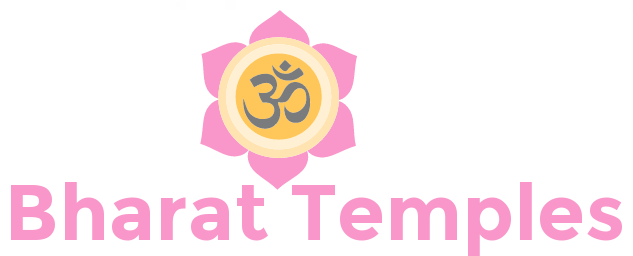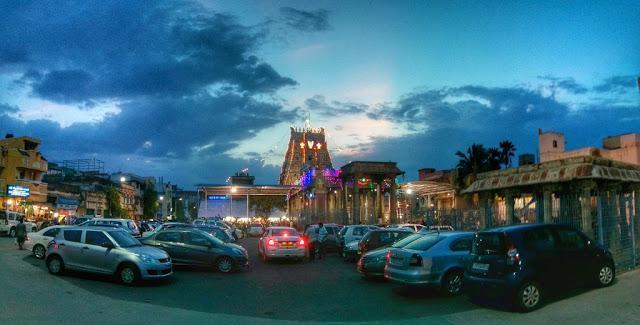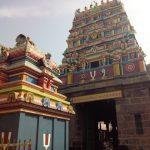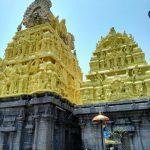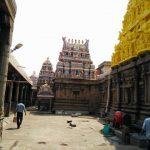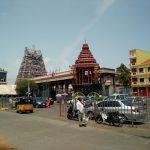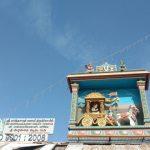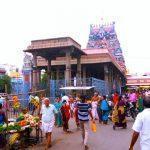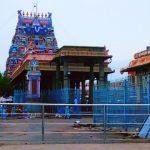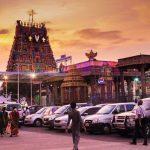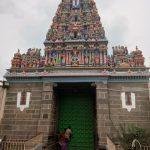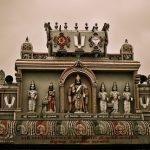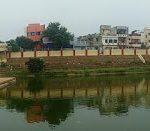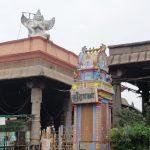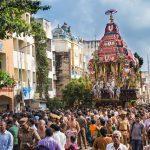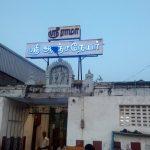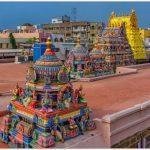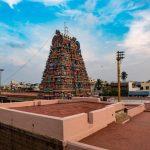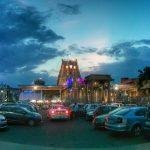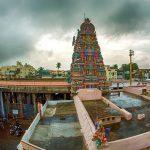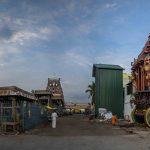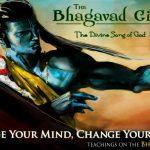Contents
Parthasarathy Temple, Triplicane, Chennai
| Date built: | – |
|---|---|
| Deity: | Parthasarathy |
| Architectural style: | Dravidian architecture |
| Major festivals | – |
| Locale: | Triplicane |
| District:: | Chennai |
| Address: | Parthasarathy Temple,Tiruvallikeni, Chennai – 600 005 |
| Phone | +91 44 2844 2462 / 2844 2449 |
The temple is one of the oldest structures in Chennai. It was originally built by the Pallavas in the 8th century by king Narasimha Varman I. The temple has icons of five forms of Vishnu: Narasimha, Rama, Gajendra Varadaraja, Ranganatha and Krishna. The temple subscribes to Vaikhanasa agama and follows Thenkalai tradition. There are separate entrances for the Krishna and Narasimha temples. The gopuram (towers) and mandapas (pillars) are decorated with elaborate carvings, a standard feature of South Indian Temple Architecture. Swami Vivekananda, Maths genius Ramanujam, politician Sathyamurthy had worshipped Lord Parthasarathy.
The Parthasarathy Swamy temple in Tiruvallikeni is the only Divya Desam among the 108 strictly within Chennai city limits. The other two Divya Desams close to Chennai are the Nithyakalyana Perumal temple in Thiruvidandai and the Ranganatha Swami temple in Thiruneermalai (both in Kanchipuram District). Steeped in mythologies and eulogized by the Azhwars in their sacred hymns in Tamil glorified as Divya Prabhandham the Parthasarathy temple at Tiruvallikeni or Triplicane, as the Britishers called it, happens to be the oldest temple in the city.
The existence of the Tiruvallikeni village is seen in records dating back to the Pallava period and earlier. One of the distinguishing features of Parthasarathy Temple is that it has representations of four incarnations or avatars of Vishnu: Narasimha, Rama, Varaha and Krishna. It also has letters written to the deity by Swami Vivekananda from the USA as he wanted to share his achievements with someone about spreading the message of Hinduism in the World Parliament of Religions that was held in Chicago on September 11, 1893. He chose Parthasarathy.
Temple Opening Time
The temple remains open from 6.00 a.m. to 12.00 a.m. and from 4.00 p.m. and 9.00 p.m.
Architecture
Legend / Local stories
Lord Vishnu darshan to King Sumathi Rajan:
Vishnu devotee, king Sumathirajan by name had a desire to have the darshan of Lord as the Sarathy of Arjuna in the Kurukshetra battle field. He prayed to God for the darshan which Lord obliged as controlling and managing the Rath of Partha-Arjuna. The king begged the Lord to stay in the place in the same form. Perumal appears only with his conch and not the discus. Lord absorbed the arrows shot by Bhishma aimed at Arjuna and thus sustained injuries. The scars are visible even now. Parthasarathy is the procession deity. As he grew prominent among the devotees, the temple came to be known as Parthasarathy temple.
Parthasarathy:
As per Mahabharata, Vishnu, in his avatar as Krishna was acting as charioteer for Arjuna, the Pandava prince during the war with Kauravas. Krishna did not take any weapons during the war. During the fight between Arjuna and Bhishma, Krishna was injured by the arrow from Bhishma. The mark in the image in the temple is believed to follow the legend. These scars are visible in Lord’s face even now. Based on this history, Perumal is praised as Parthasarathy – driver of Partha-Arjuna. The Ghee component in the Nivedhana is more to cure these wounds, it is said. No spices are used in the Nivedhanas to Lord. Praying to Lord Parthasarathy, people of unattractive complexion will understand the truth that beauty is not a constant one but may or will vanish one day due to age, illness or any other incidents in life.
Mother Vedavalli married Lord Ranganatha here:
In days of yore, Sage Brugu performed penance here to have Lord as his son-in-law. He found a female child in the Alli flower in the Pushkarini here. He took the child, named her Vedavalli. When she attained the marriageable age, Lord Ranganatha came to this place and married her. This wedding festival is celebrated in the temple on the 12th day-Dwadasi in full moon fortnight in the month of Masi-February-March. Vedavalli Thayar blesses the devotees from her own separate shrine. She does not come out in procession outside the temple but goes around the prakara only on Fridays and Uthiram star days.
People worshipped Lord Vishnu here:
Rukmini, Thondaiman, Sumathirajan, Arjuna, Bhrigu Maharishi, Markandeya, Madhuman Maharishi, Saptharoma, Saptha Rishis, Athrimaharishi, Jajalimaharishi, Aniruddha, Pradyumna & Balarama worshipped Lord Vishnu here.
Ramanuja’s father conducted an yagna to get Ramanujar as his son:
Ramanuja’s father Aasoori Kesavacharyar conducted an yagna here and got Ramanujar as his son.
Sage Madhuman got darshan of Lord Rama here:
Madhuman, son of a rishi called Sashivadan, heard of the story of Rama from Gargeya rishi, upon whose advice, he came to Brindaranya. Here he performed penance for a darshan of Rama. The Lord obliged appearing with Sita Devi and his brothers Bharata, Shatrugna and Lakshmana. Unlike the Ranganatha in Srirangam, the Ranganatha in Tiruvallikeni does not face south, but east. But Rama here faces south probably to reassure Vibhishana that he is watching over him.
Saptharoma Maharishi got darshan of Gajendra Varadhar here:
Gajendra Varadhar is said to have been worshipped by Saptharoma Maharishi in accordance with the Vaikhanasa Agamam. The Moolavar is worshipped as Sri Gajendra Varadaraja Swamy as he has given Moksha to Gajendra after saving him from the jaws of a crocodile. The Lord in heaven heard the appealing tone of his Bhakta Gajendra who was dragged into the waters by the crocodile and he rushed to the spot seating on Garuda, the king of birds, holding discuss in one hand and conch in another to save his Bhakta and threw the discus at the crocodile and saved him from death.
Scars in Lord’s face:
In olden days, though the idol of the Lord was cast three times, the face of the Lord continues to have pimples. As the sculptor was worried about it, Venkatakrishnar appeared in his dream and convinced him that he (Krishna) has received injuries on the face by the arrows shot at him, at the Mahabharata war, he appeared so to remind them. The idol of Lord Parthasarathy is fine with all the other parts smooth except the face with its marks. Not only that; the toe next to the big toe in the left leg is without nail. The arrow shot by Bhishma to mark his surrender hit the nail of Krishna. At the hip of Parthasarathy there is a scar, it is said, which was formed as Yasodha tied a rope around the hip.
Sage Atreya installed Lord Vishnu here:
Sage Atreya requested Vedavyasa to mention to him a place fit for tapas. Vedavyasa directed Sage Atreya to go to Brindaranya, on the banks of the Kairavani Theertham, where King Sumathi was doing tapas. Vedavyasa also gave a Divya Mangala Vigraha (image) with a conch in his right hand and Gnana Mudra in his left hand. Sage Atreya installed Lord here and worshipped.
Alwars praise on Lord Vishnu:
Among the 12 Alwars three of them namely Peyalvar, Thirumazhisai Alwar and Thirumangai Alwar have sung on the different forms of God in this temple.
Resting place for Pilgrims:
It has been a resting place for pilgrims who had come down from Thirupathi to have a bath in the sea on the days of Solar and Lunar Eclipses and on other auspicious days it being in a direct line to Thirupathi, Thiruthani and Trivellore and the route being free from swamps.
Sage Athri got darshan of Lord Narasimha:
It is said that the Lord Narasimha Swamy appeared to Athri Maharishi being pleased with his tapas and at his request took his Abode in Brindaranya.
Saptha Rishis worshipped Lord Vishnu here:
As per Hindu legend, Saptarishis, the seven sages worshipped five deities Panchaveeras, namely, Venkata Krishnaswamy, Rukmini, Satyaki, Balarama, Pradyumna and Aniruddha.
Allikeni:
The place is called Allikeni, meaning a pond of lily as it is believed that historically the place was full of lily ponds.
Lord Vishnu sporting a mustache here:
The place is the only place where the presiding deity is sported with a mustache.
Brindaranya:
The purana refers to the area as Brindaranya because of the Thulasi (Brinda) plants here.
Notable personalities association with this temple:
Thyagarajar, Muthuswamy Dikshitar and Bharathiyar lived here. Vivekananda also visited this temple.
Pooja Details
| Timings | Poojas |
| 5.50 A.M. | Thirumanjana Kudam |
| 5.55 A.M. | Subrabhadham |
| 6.00 A.M. | Vishwaroopam |
| 6.15 A.M. | Thiruvaradanam |
| 8.00 A.M. | Kalasanthi Theertham |
| 11.00 A.M. | Uchikkala Pooja |
| 12.30 P.M. | Thirukkappu (Closing) |
| 4.00 P.M. | Thirukkappu (Opening) |
| 6.00 P.M. | Nithya Anusanthanam |
| 7.30 P.M. | Thiruvaradanam (Night Pooja) |
| 9.00 P.M. | Arthajamam (Except Saturdays and special |
Photo Gallery
Festivals
Tiruvallikeni is noted for its colourful festivals throughout the year. The recitation of the 4,000 hymns of the Azhwars is a great tradition preserved in this temple for generations. During festival days, the place is given a new look and accompanied by various traditional rites. Triplicane is known for celebrations held throughout the year. There are festivals held specifically for each of the deities round the year. The temple is administered by the Hindu Religious and Endowment Board of the Government of Tamil Nadu. The temple follows the traditions of the Thenkalai sect of Vaishnavite tradition and follows Vaikanasa Aagama.
Utsavams take place around the year in Parthasarathy temple. Urchavams (or Utsavams), as these are termed, take place for a god at a particular period of time in the year. It is a religious practice to carry the different gods of the temple through the Mada veethis of Triplicane during some of these festivals. The Gods will move in different religiously built temple vehicles (vahanams, as these are termed in Tamil), like Elephant, Garuda, horse, Yali (a mythical animal), temple Rath (Ther in Tamil, chariot or Ratham, alternative terms), etc.
Theppam (Float) Festival:
Theppam Festival is also known Theppotsavam (Theppam + Utsavam), this pictorial and colourful festival takes place on 7 days in the Tamil month of Masi, 3 days for Lord Parthasarathy, one each for Sri Narasimhar, Sri Ranganathar, Sri Ramar and Sri Gajendra Varadhar. The seven-day event attracts many devotees and onlookers from different parts of Chennai and Tamil Nadu. A floating structure made up of drums, timber would be constructed and would be beautifully decorated with lights, flowers, religious paintings, silken buntings, etc. which serves as a visual delight. For better ambience, lights were also installed in the garden around the tank and additionally, focus lights were placed on the corners of the Neerazhi Mandapam (the mandapam (structure) in the center of the temple tank).
Perumal (God) would come to the temple tank in Purapadu (departure) and be placed majestically inside the float. On all the days, the float completed five rounds around the Neerazhi Mandapam. After this, the deities were taken in a procession around the four Mada Streets. Devotees in hundreds would converge and sit on the steps of the temple tank to have darshan of the Lord on Theppam. The specialty of the third day function is the ‘Thirumanjanam’, performed to the deity inside the float. Other than the bhattachariars (temple priests), no one is allowed inside the float. A Rescue team of about 10 swimmers is usually provided by the Tamil Nadu Fire and Rescue Services.
This Theppam festival exhibits one of the aspects of the richest cultural heritage aspects of Triplicane which one can see nowhere else in Chennai, other than Mylapore.
Thiru Adi Puram Festival:
A separate shrine is built for Sri Andal – the incarnation of Bhu Devi and the festivals are being celebrated monthly and annually. In the month of Adi (June-July) Thiru Adi Puram festival for ten days is celebrated ending with the procession of Andal with Sri Parthasarathy Swamy on Pura Thirunakshatram day (Thiru Aadippooram), the birth star of Sri Andal.
Neerattu Utsavam:
Neerattu Utsavam for nine days is also done in the month of Margazhi (December-January) ending with Bhogi Thirukalyanam with Sri Parthasarathy Swamy.
Deepa Alankara Festival:
During Karthika Masa (October- November), Deepa Alankara festival is celebrated, when lights of various sizes and shapes are lit throughout the month. On the day of Karthika Poornima, full moon day, lakhs of devotees throng to the temple and light lamps.
Dhavana Uthsavam:
Dhavana Uthsavam is celebrated for 3 days in the month of Masi commencing from Swathi Thirunakshatram.
Theerthavari Festival:
In the month of Masi (March- April) a festival for Lord Parthasarathy known as Theerthavari festival is held at sea shore.
Pallava Uthsavam:
Pallava Uthsavam is celebrated for five days in the month of Panguni and Sthala Puranam is read on all days of the festival and the festival ends with Thirukalyanam with Vedavalli Thayar on the Panguni Uthiram day.
Thirukalyanam:
The wedding of Lord Ranganatha with Vedavalli is celebrated annually during Masi Shukla Dwadashi (12th day in the month of January- February)
Navarathri Festival:
Navarathri festival ending with Mahanavami is celebrated in the month of Purattasi (September-October).
Narasimha Jayanthi:
Sri Narasimha Jayanthi, the birth day of Shri Narasimha, is celebrated on the Suddha Cathurdasi day in the month of Vaikasi.
Hanumanth Jayanthi:
Hanumanth Jayanthi with procession is done on the day of Suddhya Thrayodasi in the month of Margazhi.
Rama Navami:
Sri Rama Navami festival is celebrated in the month of Panguni and on the third day morning, Garuda Vahana procession is conducted.
Vaikunta Ekadashi:
Vaikunta Ekadashi, during December- January is one of the important festivals celebrated with great fervor. It is generally believed that people who go through the Vaikunta Dwara on Vaikunta Ekadashi day will reach Vaikunta, the abode of Lord Vishnu after their death.
Other Festivals:
Festivals are done to Sri Thayar on every Friday and the procession is carried out within the precincts of the temple Thirumanjanam or holy bath is done on every Friday. Procession on every Swathi Thirunakshatram day being the day when he appeared to Athri Rishi, is conducted in the four small Mada veethis.
The following are the various festivals or Urchavams or Utsavams or Utsav in Parthasarathy temple in different parts of the Tamil Calendar year.
| Traditional Tamil calendar month (Gregorian calendar months) | Festivals |
| Chithirai (April–May) | Shri Brahma Utsavam (Brahmotsavam) – Lord Shri Brahma himself will perform this most important festival. Seer Shri Udayavar Utsavam Vidaiyaatri (Concluding and Leave-Taking Ceremony). |
| Vaikasi (May–June) | Vasanthotsavam- Spring Festival Shri Gajendra Varadaraja Swamy Utsavam Shri Ranganatha-Shri Vedavalli Thayar Utsavam Sri Nammalwar Uthsavam (Vaikasi – Visagam) |
| Aani (June–July) | Shri Narasimha Swami Brahmotsavam Kodai Utsavam (Summer Festival) |
| Aadi (July–August) | Shri Gajendra Moksham (Salvage for Gajendra-King of Elephants) Shri Parthasarathy Jestabishekam Thiru Pavadai Utsavam Thiru Aadi Pooram – Birthday of Andal on her Birth Zodiacal Star |
| Aavani (August–September) | Pavitrotsavam (Thiru Pavithra Utsav) – Sanctification ceremony Shri Jayanthi or Krishna Jayanthi (Birthday of Lord Krishna) |
| Puratasi (September–October) | Navarathri -Festival of nine lights Shri Vedavalli Thaayar Laksharchana |
| Aipasi (October–November) | Shri Manavaala Mamunigal Utsavam Deepavali or Diwali – Festival of Lights Anna kooda Utsavam- offering variety of rice |
| Karthigai (November–December) | Thiru Karthigai Deepam – Various and Varied Lights Thaila Kappu – anointing of several medicinal oils or his/her corporal |
| Margazhi (December–January) | Margazhi Pagal Pathu (Days-Ten) Shri Vaikunta Ekadasi (Entering Heaven) Raa Pathu (Night-Ten) |
| Thai (January–February) | Laksharchana of Shri Parthasarathy Swamy Ratha Sapthami (Ratha-Car, Sapthami-Seventh Lunar Occasion) Visiting Festival to Ekkatuthangal |
| Masi (February–March) | Masi Magam (Magam-star day) Theppam or Theppotsavam (Float Festival in Temple Tank) Dhavana Utsavam (Spring Festival) |
| Panguni (March–April) | Panguni Uthiram (Uthiram – a star day) Shri Rama Navami (Birthday of Lord Ram) |
Nivedhana:
Some Nivedhanas are famous in Perumal temples – Tirupati Laddu, saltless rice in Uppiliappan Koil and Dosa in Madurai Kallazhagar temple. Sweet Pudding – Sarkarai Pongal is famous in Parthasarathy temple. For every 2-kg rice, they add 400 gm cashew nuts and 700 gm ghee in the preparation. Devotees can pay and get it prepared for them for the Nivedhana of Lord.
How to Reach:
Triplicane (Tiruvallikeni) is an important division in Chennai city. The Temple is located at about 1 Km from Marina Beach, 7 Kms from Nungambakkam, 7 Kms from T Nagar, 11 Kms from Anna Nagar and 10 Kms from Vadapalani.
By Road:
Town buses are available from every corner of the city to reach the temple comfortably. The Temple is located at about 1 Km from Lyolds Road Bus Stop, 1 Km from Triplicane Post Office Bus Stop, 1.5 Kms from Marina Beach Bus Stop and 12 Kms from Koyambedu Bus Terminus.
| Bus No | Route |
| 22 | Ayanavaram B.S to Anna Square |
| 27B | C.M.B.T. to Triplicane |
| 29A | Perambur B.S to Anna Square |
| L27L | Anna Square to Mogapair West |
| L40A | Anna Square to Avadi |
| S40A | Anna Square to Avadi |
| X22A | Ambathur Estate to Thiruvanmiyur |
| X40A | Anna Square to Avadi |
| 27BCT | M.M.D.A. Colony to Anna Square |
| L06A | Tollgate to Besant Nagar |
| M27R | Anna Square to Oragadam |
| M40ET | Anna Square to Menambedu |
| S27BCT | M.M.D.A. Colony to Anna Square |
| 45B | Anna Square to Guindy Industrial Estate |
| 32 | Vallalar Nagar to V. Illam. |
| 25G | Anna Square to Poonamallee |
| 24A | V.Illam to Anna Nagar West. |
| 29D | V.Illam to Mathur. |
By Train:
The temple is situated at about 5 Kms form the Chennai Central and Chennai Egmore Railway Stations. The Temple can be reached by the Mass Rapid Transit System of Railways and the Tiruvallikeni MRTS Station is few metres away from the Temple. Electric train facility is also available.
By Air:
Chennai International Airport is located at about 20 Kms from this Temple.
Contact Details
Parthasarathy Temple,
Tiruvallikeni, Chennai – 600 005
Phone: +91 44 2844 2462 / 2844 2449
Fax: +91 44 28447042
Email: parthasarathy@tnhrce.org / parthasarathyswamytemple@gmail.com
Web: www.sriparthasarathytemple.tnhrce.in
